
More Hollywood. … Yes, he was very relaxed on this very windy, dusty, hazy day in Spring Creek Basin. 🙂

More Hollywood. … Yes, he was very relaxed on this very windy, dusty, hazy day in Spring Creek Basin. 🙂

If you’re afraid of heights, you’d have had a hard time hiking with me to this spot … because I had to crawl, on hands and knees, hoping the wind wasn’t stronger than my body weight (no chance of that –ha!) because the width of the finger of shale I crawled up on to get to where I’m sitting on the ground to take this pic (below what you can see) was not much wider than my four-square hands and knees. Let’s just say that I didn’t take in the view – or the drop to either side – until I got to this point and shimmied around onto my derrière!
What. A. VIEW!
If I say that frequently about Spring Creek Basin, who could blame me – or argue? 🙂
Bonus: It’s starting to look a little green, eh? … Just a little?!
Bonus No. 2:

I knew I was going to find Sundance’s and Storm’s band up top (you think I did a death-defying hands-and-knees crawl for my health!?), but I also found Mr. Hollywood! This pic can’t begin to do justice to this view: It’s still a ridge, though it’s (much) wider than where I crawled up. The horses had already moseyed to the far end by the time I crawled and walked up to this point, which is just above and behind my spot in the first pic. You might have to zoom in to see them.
The horses take me to all the very BEST places! 🙂 There will be pix of them to come in future posts.
Oh, and I forgot to mention that although the horses didn’t follow my route UP (!!!!), they had been DOWN that little ridge – at least to the end – by the existence of desiccated manure. (Really, you find it in the craziest places!)
It MUST be spring – the prince’s plume is flowering. 🙂
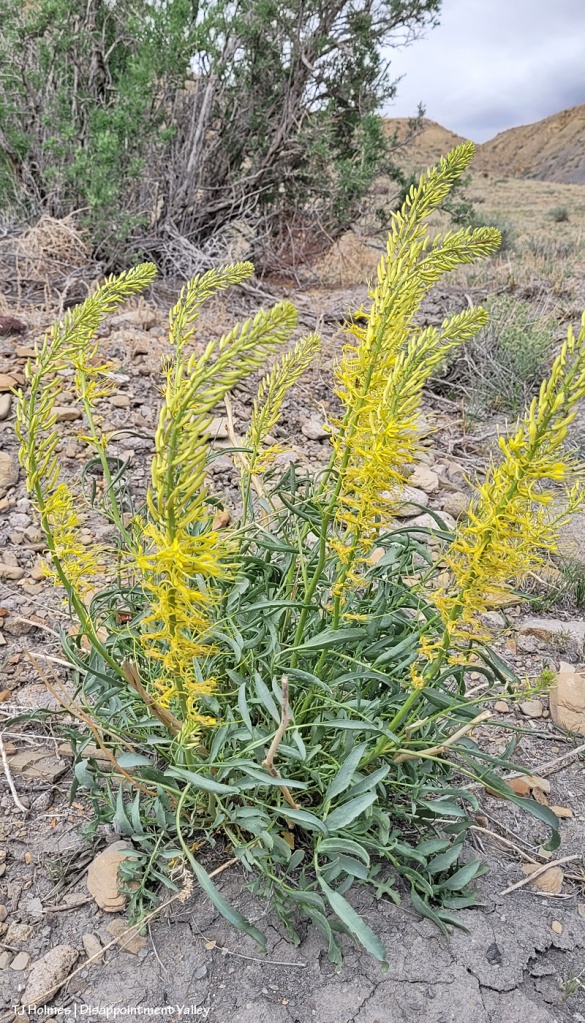
And the bees also are very happy about that:
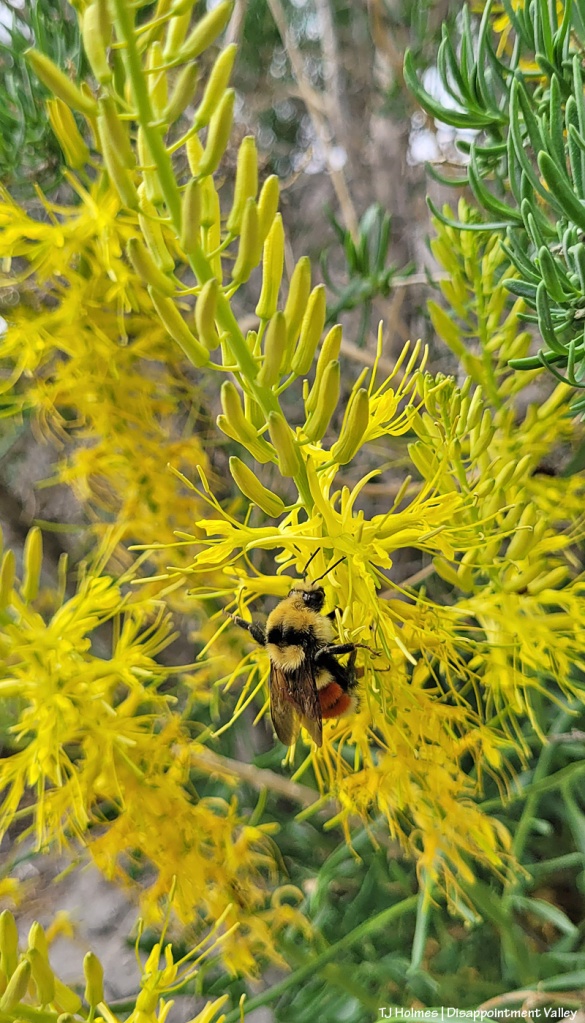
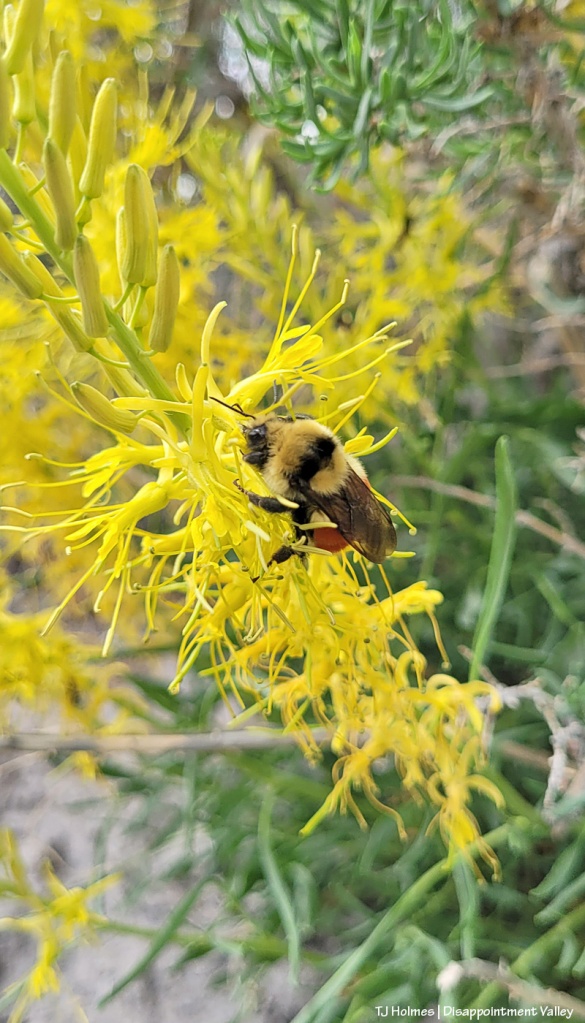
And … drum roll, please … WE GOT RAIN LAST NIGHT!!!!!!!!!!!!!!!
The first actual rain – and yes, the ground got more-than-damp wet – since April 6. It will put some water in the catchments and give the vegetation a nice, lovely drink of moisture.
*Relief*. 🙂
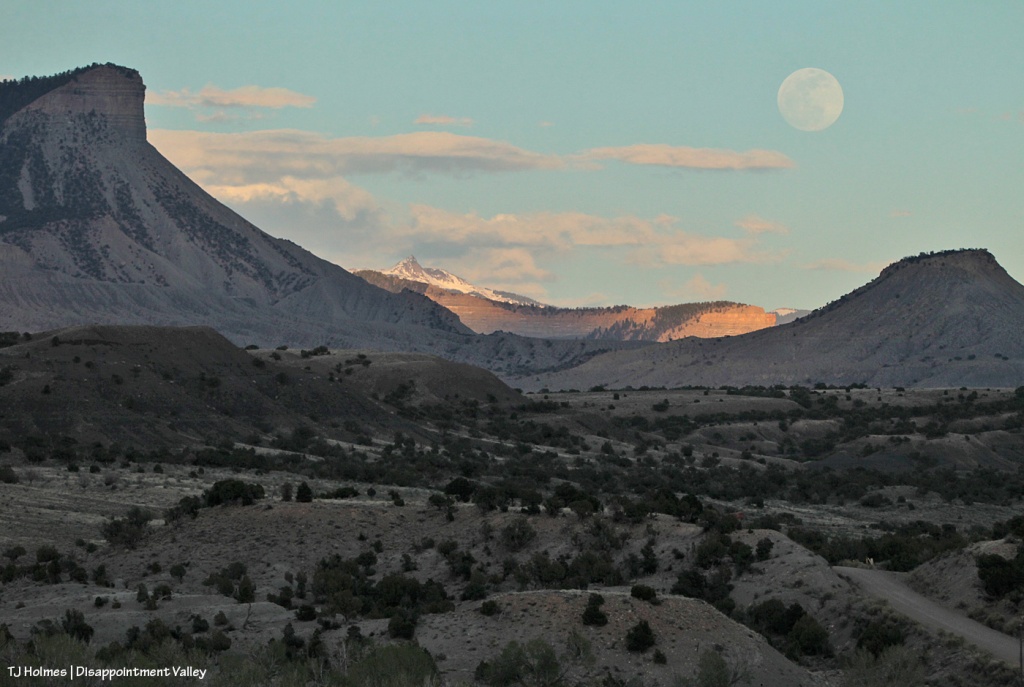
The mustangs weren’t in cooperative locations for catching the rising moon, so I tried a bit different place. I still caught it a bit later than I’d hoped, but with Temple Butte on the left and Brumley Point on the right, Groundhog Mountain in the background and part of Spring Creek Basin in the middle ground … it worked out all right. 🙂
That’s part of Disappointment Road at lower right.
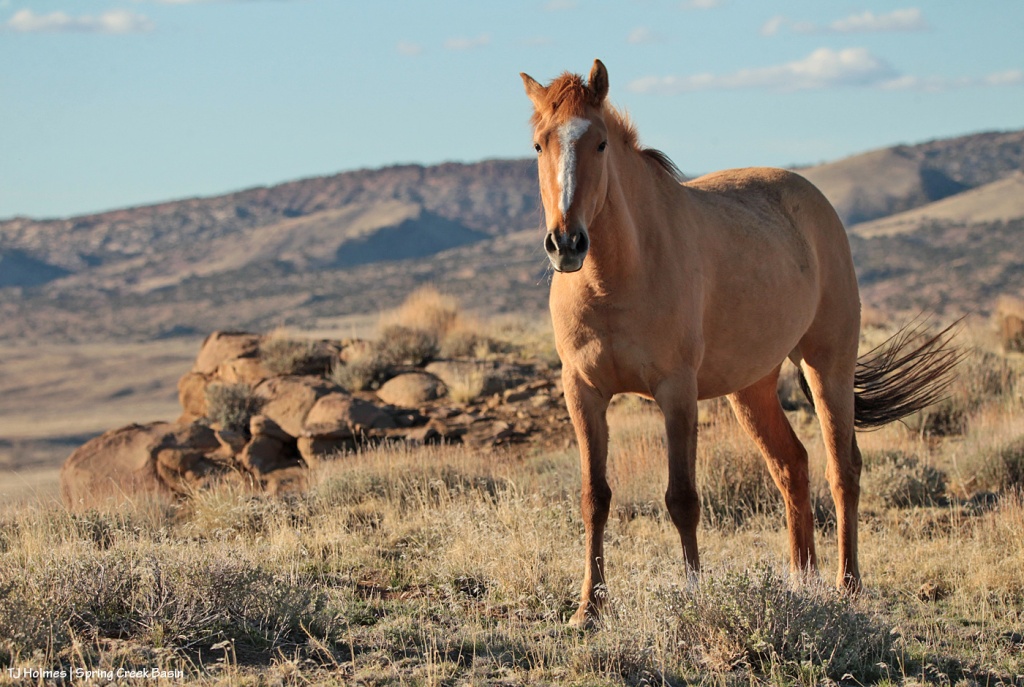
You know how, when you’re a kid (some kids … me, for example), the edges of heights don’t bother you? You can stand there, look over, look out, and you’re so confident of your balance, your groundedness to the earth, that you can’t imagine any danger? Then, when you’re an adult (some adults … me, for example), the sight of kids or animals at the edges of great heights gives you the willies, makes the ground under your own feet seem unstable, and you really want who/whatever it is to move away from the edge RIGHT NOW?
See those rocks behind/left of Dundee? They mark the rimrock edge at Spring Creek Basin’s western boundary.
I had walked up the hill where the band was grazing, and though heights bother me a bit more as an adult than they did as a kid, when at the top of the rimrocks, the desire to look over the edge, at the view, is strong. Because … what a view!

The edge of the rimrocks, which form a natural barrier for Spring Creek Basin, is in the near foreground toward the upper right. The road below is the road from the main road in Disappointment Valley to Spring Creek Basin. This view is looking northwestish across Disappointment Valley toward Utah’s La Sal Mountains.
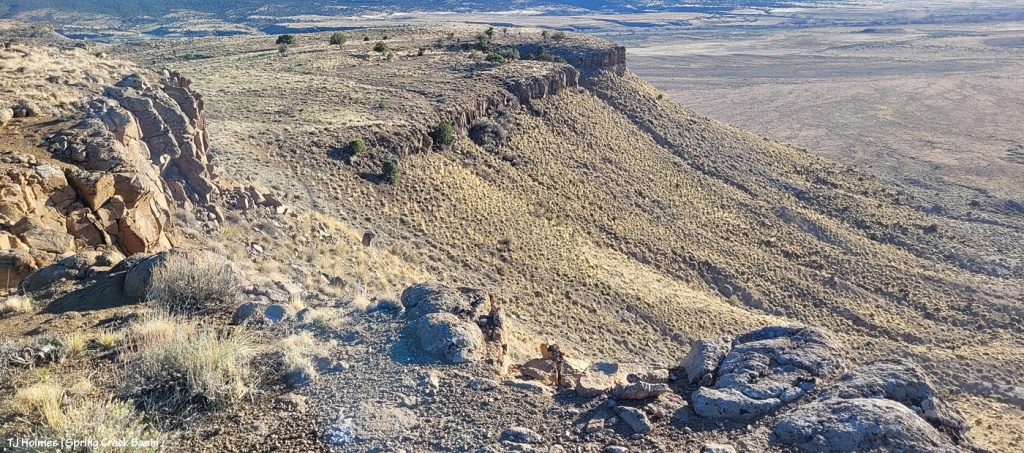
The view looking southwestish. The line of Disappointment Creek is in the far right distance.

And looking more northish.
As for Dundee, she obliged my nervousness so near the edge and headed back down to her friends and Buckeye. Whew. 🙂

On St. Patrick’s Day in Disappointment Valley, we had a bit of gold under the rainbow (and yes, it was sprinkling when I took these pix (above with my phone; below with my camera)).

In Disappointment Valley (which includes Spring Creek Basin), WATER is the treasure! In our case, there’s a whole lotta mud under that rainbow right now, and we’re feeling pretty rich. 🙂
(And yes, these pix were taken the evening of St. Patrick’s Day – no kidding!)
Well, we kinda got skunked again on snow – the big, hyped, “inches and inches are coming!” winter-weather-warning snowfall – yesterday, but we do have snow on the ground still from Friday’s surprise event – thank goodness. We got no measurable snow from Sunday, though we did have a couple of brief waves of blowing flakes, and there was snow all around Disappointment Valley.
The following pix are of snow/ice crystals on grass stalks and sagebrush in Spring Creek Basin on Friday.









It was so much more beautiful and magical than I can convey in photos.
You’ve heard the phrase “doughnut hole” in weather-related conversation? How one place or another is in a “doughnut hole” of NOT getting weather the surrounding area or region is getting or has gotten?

Disappointment Valley (at least the lower part) got a skiff or less of snow Thursday morning (no measurable liquid). It was gone (melted) before you could even say “doughnut hole.” A friend west of Cortez (south of Disappointment) got 4 inches of snow. A friend right in Durango got 6 inches! Friends in Aztec, New Mexico (northern New Mexico not far south of Durango), got 3.5 inches of snow. … You see where I’m going with this?

Yeah, it’s a thing.
That’s Disappointment Road looking south. This is the afternoon of the morning it snowed – “snowed” – ha.

‘Course, at the same time, we had THIS view (to the east-southeastish). 🙂 (Note the lack of snow.) That could be a definition of “silver lining.” 😉
(Next forecast snowfall: tomorrow!)

Couple of things:
Yes, it really is (still) that dry in Spring Creek Basin and most of the rest of southwestern Colorado. Pooh on the U.S. Drought Monitor for thinking (erroneously in my oh-so-very-humble opinion) that we’re only “moderately dry.”
And: proof that mustangs and mountain goats have a common ancestor (!). 🙂
That’s Sundance (and one of his mares) on a finger of a ridge at the very southeastern end of what we call Knife Edge (which actually is fairly broad on top). This pic, taken with my phone as I hiked out to a series of hills to get up to the ridge that snaked down to where his band was, isn’t even wide enough to show how far to the right I had to go to get to that access area – where I could bypass the rimrocks. The other side of this ridge features a little cove, where a couple of the horses were grazing as I drove up the road to the point where I started hiking, but it’s all rimrock-locked. In other words, the only way TO that point is back up the way they got TO it in the first place.
OK, a third thing: You know I’m going to show you all some scenery from up on that ridge, don’t you? 🙂 (Here’s a crazy thing: As much hiking as I’ve done in Spring Creek Basin during the last 21 (starting to inch up on 22?!) years, I’ve never been up on that particular ridge or on the very top of Knife Edge. … The horses are very good guides at getting me to new places. :))

Upon leaving my buggy to start my hike (the big ridge and Sundance’s band are directly to my left), this was the first view that made me reach for my phone (aka easy-to-access camera). I’m just south of an area of Spring Creek Basin that I call the east pocket. Knife Edge is basically to about my 11 o’clock, and the sandy-colored ridges at the right of the image are what I call Valentine Mesa. The mountains are a stone’s throw away (!) in Utah; from the ridge I was later on with the horses, they’re mostly blocked by the bulk of Knife Edge.

I’m up on the ridge that leads to the horses’ location farther down at the fingertip end of it. That big rise of grey Mancos shale and orangier (!) sandstone is Knife Edge. The southern peaks of the mountains are just visible way, way out against the turquoise sky. Spring Creek canyon is visible at far left. That’s the basin’s western boundary; the farthest treed ridges are the southern/southwestern boundary of Disappointment Valley above the Dolores River and its canyons.

Looking left-ish from the above pic, that’s Spring Creek cutting through Spring Creek Basin in the middle ground. What I call the “weeping wall” is down there, and it provides a pretty constant source of trickling water for the mustangs. At far upper right is the eastern end of Filly Peak in the basin’s western region, and straight out is Flat Top. Round Top is barely visible at left. In about the middle ground – shadowed on its northeastish length – is the ridge I call rollercoaster (though it doesn’t look very rollercoastery from this perspective). … And see the glimmer just above/beyond it? That’s the rollercoaster ridge pond, still decently full of water (semi-frozen, depending on conditions). That’s the pond from the “Reflections” post recently. … And what do McKenna Peak and Temple Butte look like from THIS perspective?

I’m so glad you wondered! 🙂 From a little right of left: Temple Butte, McKenna Peak, what I call submarine ridge (you can see the two “arm” ridges of the actual feature from here) and Brumley Point, on Spring Creek Basin’s southeastern boundary. The Glade is in the far distance, touching the sky. A little closer – middle ground – is Spring Creek and part of the basin’s loop road (rough, and I would not recommend driving a vehicle on this section). The ridge down to the horses starts to the left and runs through the nearer middle of the pic. Sundance was actually partially visible (his back), but I don’t think he shows up very well in this pic.

This pic (left) and the next (right) were taken from the same vantage point, but when I tried to stitch them together into a bit of a panorama in Photoshop, it didn’t work out so well. So, using the ridge in front of me as your guide, you’ll have to use your imagination a bit as you scroll up and down to look left and right (!).

If you can find the ribbon of road, out there in sort of the middle, heading uphill (to the left from this perspective), is where I was when I looked up and horses appeared, much to my wondering eyes! (Magic isn’t just the domain of Santa, folks.) If I’d been going the other way around the loop, downhill, which is my usual direction and preference given some fairly challenging road issues (!), I don’t think I’d have seen them because I’d have had to look back over my shoulder and up. I try to look in that area because I’ve seen Sundance’s band in that relative vicinity before, but see the little “cove” down to the right in the second pic (the one right above)? That’s where a couple of the horses were when I first spotted them from below, and if I’d been in a different place, I wouldn’t – couldn’t – have seen them there from the road.
Another lesson: Perspective often is everything. 🙂
Pretty dry out there. The forecast is starting to show us some glimmers of hope for coming snow. We got kind of skunked over Christmas, but fingers and hooves are crossed that our winter will start picking up in this newest part of the new year.